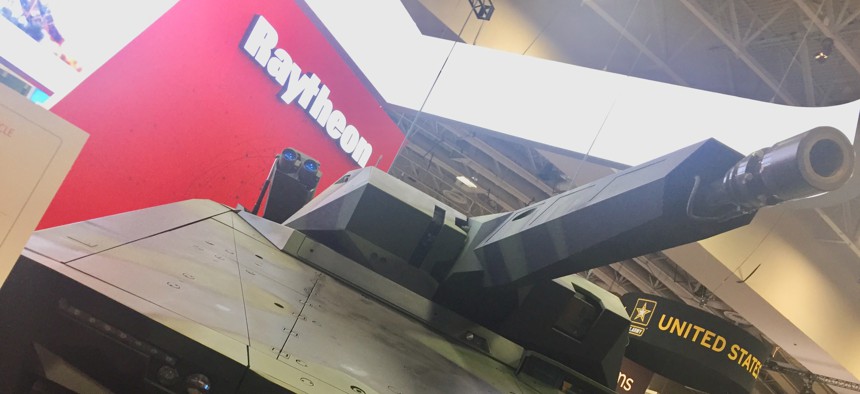
A Rheinmetall Lynx armored vehicle at the Association of the U.S. Army conference in Washington. Marcus Weisgerber/Defense One
Foreign Weapons Get a Closer Look as the Pentagon Races to Rearm
That’s why Raytheon and others are eagerly courting non-U.S. partners with state-of-the-art gear.
Deep inside the Washington Convention Center, underneath the bright-white-and-red logo of one of America’s biggest defense firms, sat a green-hulled armored vehicle with a curiously angular gun housing — and an even more curious pitch for customers who generally buy American.
Raytheon has high hopes for the Lynx, a new fighting vehicle designed by Rheinmetall in Germany — and perhaps one day, manufactured in the United States. And as the Pentagon begins to prioritize speed of acquisition over its traditional protectionism, this maker of missiles, rocket interceptors, and cyber defenses is placing bets on foreign partners with state-of-the-art products.
“For us, this is sort of a change in speed and direction for Raytheon,” said Richard Harris, vice president of business development for the company’s Land Warfare Systems division.
The Massachusetts-based firm is not the only defense giant pivoting as the Pentagon signals an urgent desire for weapons that might face off against Russia and China. After nearly a generation spent focusing on counter-insurgency, many American defense firms are looking overseas for the latest and greatest in armored vehicles, anti-tank rockets, and other necessities of great-power conflict.
Related: Trump Wants Chinese Parts Out of American Weapons
Related: General Motors Wants to Disrupt the Military Truck Market
Related: An Italian-Designed, American-Built Helicopter Will Replace US Air Force Hueys
That shift was on full display this week at the Association of the U.S. Army’s annual conference in Washington, the largest military arms show in the United States.
Start with the Lynx, whose appearance in this vast exhibit hall marks the consummation of a courtship begun several years ago.
“We have worked with [Raytheon] from the beginning as we were conceiving of this vehicle. We have overlapping and complementary technology and capabilities,” said Stephen Hedger, who leads Rheinmetall’s U.S. business. “Obviously for the U.S. market, having a U.S. partner for a vehicle that you are going to Americanize and produce in America is critical.”
The two companies sealed their deal in June at a Parisian arms show, where they pledged to bring the Lynx to AUSA. If the Raytheon-Rheinmetall team manage to sell the roughly 40-ton vehicle to the U.S. Army, which is looking for a next-generation combat vehicle, they plan to manufacture it in a U.S. plant.
“Rheinmetall brings an infusion of manufacturing technology and jobs into this country that we sorely need right now,” Harris said.
For now, the Lynx looks to face competition from General Dynamics and BAE Systems. No matter who wins, some Raytheon-made equipment will likely find its way onto the armored vehicle. But a Lynx sale would add new business to Raytheon’s portfolio.
And there are more examples. When the U.S. Navy sought arms for its littoral combat ship, Raytheon helped win the deal in May for the Naval Strike Missile, designed and made by Kongsberg in Norway. The U.S. company is also working with Sweden’s Saab to pitch a new version of the Carl Gustaf anti-tank rocket to the U.S. Army.
Elsewhere at AUSA, a light tank sat under a blue SAIC sign. The tank itself is made by Singapore-based ST Engineering, but much of its internal electronics would be installed by SAIC.
“We thrive on partnerships, not just in our home country, but everywhere around the world in defense and non-defense,” Vincent Chong, president and CEO of ST Engineering, said in an interview. “I think that’s the way to capture value collectively, because in today’s world, you have to offer a total system solution and you have to know how to leverage on the strength partners bring to go to market.”
While in the past, foreign bidders were longshots against their American counterparts, the Pentagon has recently picked several overseas designs. Last month, Boeing captured a $9.2 billion deal to build new T-X pilot training jets for the U.S. Air Force. It designed the plane from scratch with Saab. Boeing also won a $2.4 billion deal to replace Air Force UH-1N helicopters with a bid that included the Italian-made AW139 commercial helicopter.
“For Boeing, the T-X win (along with the recently won MQ-25 [Navy drone] and UH-1N [replacement]) helps shift the focus to Boeing Defense (BDS) … and highlights that it’s more than just tankers and legacy fighters,” Citi analyst Jon Raviv wrote in a Sept. 27 note to investors. “For Saab, it increases exposure to US defense growth and opens the door for future cooperation with US defense primes.”
Notable U.S.-Foreign Team-ups
- Boeing and Saab won the $9.2 billion U.S. Air Force T-X pilot training jet competition. Saab helped Boeing develop the jet, which will be built in St. Louis, from scratch. The three aircraft that completed all had a foreign flavor.
- Boeing and Leonardo won the $2.4 billion U.S. Air Force UH-1N Huey Replacement competition. They will supply commercial AW139 helicopters, which will be made in Philadelphia. They beat the venerable Sikorsky Black Hawk military helicopter.
- Boeing, which acquired Embraer’s commercial business earlier this year, is teamed with the Brazilian firm to market the KC-390 transport, which competes against the Lockheed Martin C-130J. A report said Boeing is considering a KC-390 assembly line in the U.S.
- Raytheon and Rheinmetall are pitching the Lynx 41 infantry fighting vehicle for the Army’s next-generation combat vehicle.
- Raytheon and Saab are pitching the Army a new version of the Carl Gustaf anti-tank rocket.
- Raytheon and Kongsberg won an $848 million contract to build anti-ship missiles for U.S. Navy Littoral Combat Ships.
- SAIC and ST Engineering for the Army’s Mobile Protected Firepower program.




